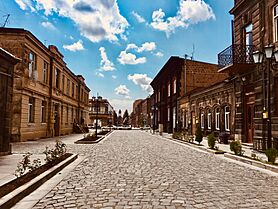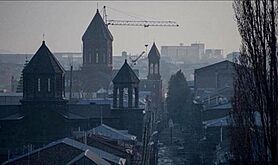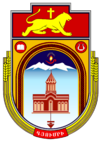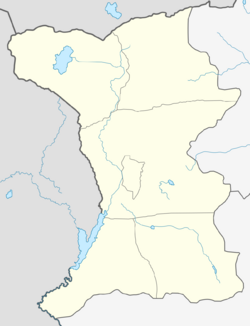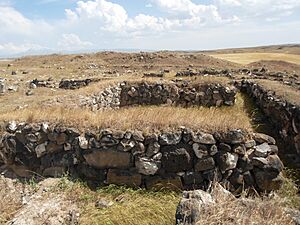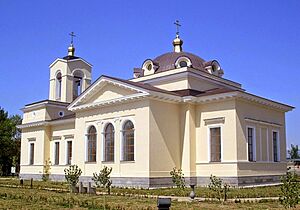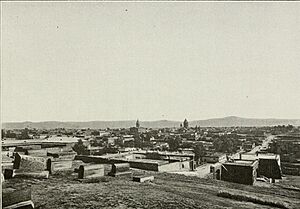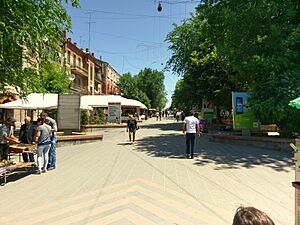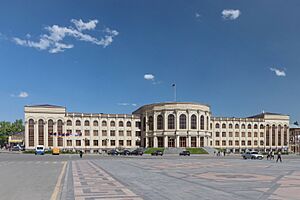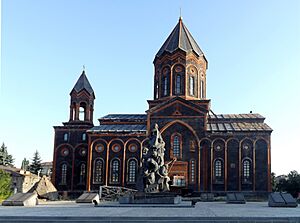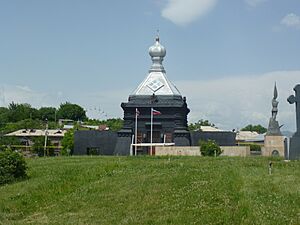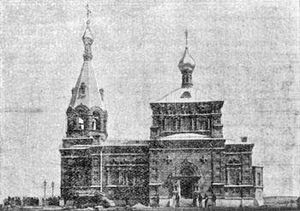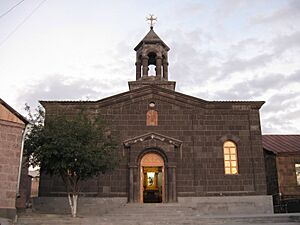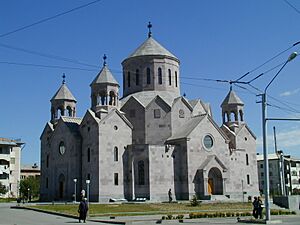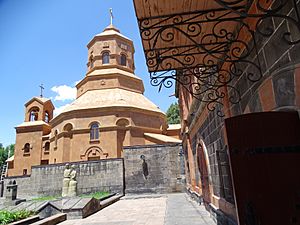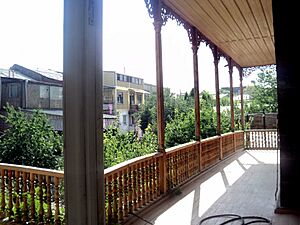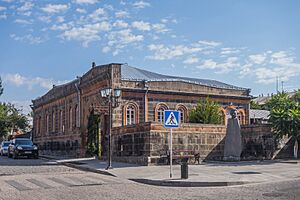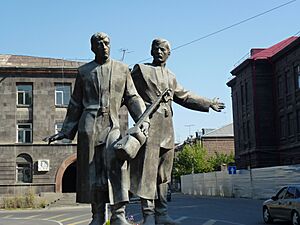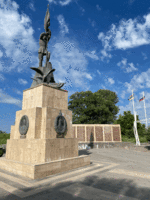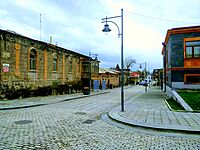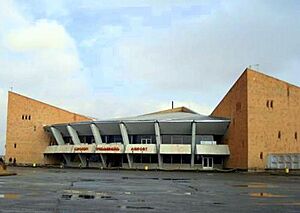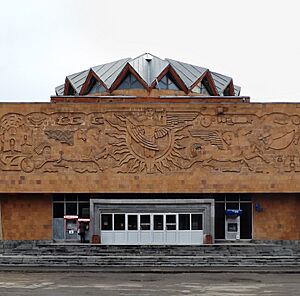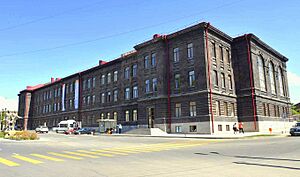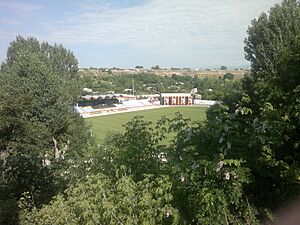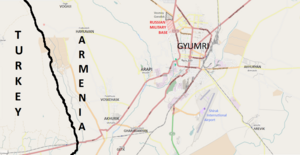Gyumri facts for kids
Quick facts for kids
Gyumri
Գյումրի
|
|||
|---|---|---|---|
|
City and urban community
|
|||
|
From top down, left to right;
Abovyan street view • City Hall • Cathedral of Gyumri • Dzitoghtsyan Museum of National Architecture • Independence Square • Gyumri skyline |
|||
|
|||
| Nickname(s):
Hayrakaghak ("Father-city")
|
|||
| Country | Armenia | ||
| Province | Shirak | ||
| Founded as Kumayri by the Urartians | 8th century BC | ||
| Rebuilt as Alexandropol by Nicholas I of Russia | 1837 | ||
| Government | |||
| • Type | Mayor–council | ||
| Area | |||
| • Total | 54 km2 (21 sq mi) | ||
| Elevation | 1,509 m (4,951 ft) | ||
| Population
(2011 census)
|
|||
| • Total | 121,976 | ||
| • Estimate
(1 October 2019)
|
112,600 | ||
| • Density | 2,259/km2 (5,850/sq mi) | ||
| Demonym(s) | Gyumretsi | ||
| Time zone | UTC+4 (AMT) | ||
| Postal code |
3101-3126
|
||
| Area code(s) | (+374) 312 | ||
| Vehicle registration | 45 am | ||
| Climate | Dfb | ||
| Sources: Population | |||
Gyumri (Armenian: Գյումրի) is the second-largest city in Armenia. It is the main city of Shirak Province in the northwestern part of the country. By the late 1800s, when it was called Alexandropol, it became the biggest city in Russian-controlled Eastern Armenia, even larger than Yerevan. The city was known for its culture and was an important base for Russian troops during wars in the 19th century.
During and after World War I, the city faced many challenges. After the October Revolution, Russian forces left the area. Many Armenian refugees, especially 22,000 orphaned children, came to the city to escape the Armenian genocide. The city was renamed Leninakan during the Soviet era. It became a major center for factories and textiles in Soviet Armenia. Before the 1988 Armenian earthquake, the city's population grew to over 200,000. The earthquake caused huge damage, and the population dropped to 121,976 by 2011. After the Soviet Union broke up, the city was renamed Gyumri. Efforts to rebuild the city are still ongoing.
Today, Gyumri is still dealing with the effects of the 1988 earthquake. However, it remains famous as Armenia's cultural heart. Many artists and craftspeople come from here. The city is also special because of its large Kumayri historic district. This old part of the city mostly survived the earthquake. It dates back to the 1800s and shows real Armenian architecture.
Contents
- What is the History of Gyumri's Name?
- Exploring Gyumri's Past: A Timeline
- Where is Gyumri Located and What is its Climate Like?
- Who Lives in Gyumri?
- What is Gyumri's Culture Like?
- How Do People Get Around in Gyumri?
- What is Gyumri's Economy Like?
- Learning and Technology in Gyumri
- Sports in Gyumri
- Sister Cities of Gyumri
- Famous People from Gyumri
- See also
What is the History of Gyumri's Name?
The area where Gyumri is today was first called Kumayri (Armenian: Կումայրի). This name was used during the time of the Urartu Kingdom. Over time, the name changed to Kumri, then Gumri, and finally Gyumri.
In 1837, the city was renamed Alexandropol. This was done to honor Czar Nicholas I's wife, Princess Alexandra Fyodorovna. From 1924 to 1990, the city was known as Leninakan, named after Vladimir Lenin. After Armenia became independent, the name Kumayri was used briefly until 1992, when Gyumri was chosen as the city's official name.
Exploring Gyumri's Past: A Timeline
Ancient Times: From Urartu to Armenian Kingdoms
Archaeological digs show that people have lived in the Gyumri area since at least 3000 BC. The area was first mentioned as Kumayri in ancient writings from the Urartu Kingdom around 800 BC. Some historians think Kumayri might be the city of Gymnias or Gumnias mentioned by Xenophon in his book Anabasis.
When the Urartu Kingdom declined around 550 BC, Kumayri became part of the Achaemenid Empire. Remains of a royal settlement from 5th to 2nd centuries BC, found near Gyumri, show this Persian influence. Later, around 500 BC, Kumayri became part of the Satrapy of Armenia under the Orontids. Another idea is that Greek settlers founded Kumayri as a city around 401 BC.
By 331 BC, the area was part of the Ayrarat province in the Ancient Armenian Kingdom. Between 190 BC and 1 AD, Kumayri was ruled by the Artaxiad dynasty. In the 1st century AD, the Kamsarakan family took control of Shirak, including Kumayri, during the Arsacid Kingdom of Armenia.
Medieval Period: Growth and Changes
After Armenia was divided in 387 AD, and the Arsacid Kingdom fell in 428 AD, Shirak and Kumayri became part of the Sasanian Empire of Persia. In 658 AD, during the Arab Islamic invasions, Kumayri was conquered and became part of the Emirate of Armenia under the Umayyad Caliphate.
Kumayri was an important and developed city in the Middle Ages. The Armenian historian Ghevond says the town was a center for the Armenian rebellion against the Islamic Arab Caliphate between 733 and 755. After 200 years of Islamic rule, the Bagratids declared independence in 885 AD, forming the Bagratid Kingdom of Armenia. Kumayri began to grow again, especially when the nearby city of Ani became the capital in 961 AD. By the late 900s, the Armenian Pahlavuni family, descendants of the Kamsarakans, influenced Kumayri. They helped Shirak by building many fortresses, monasteries, and schools.
Armenia fell to the Byzantine Empire in 1045 and then to the Seljuk invaders in 1064. Under foreign rule, the town lost its importance for centuries. This changed with the Zakarid Principality of Armenia in 1201, under the protection of Georgia. During Zakarid rule, Eastern Armenian areas like Lori and Shirak grew and became trade centers. After the Mongols captured Ani in 1236, Armenia became a Mongol protectorate. The Zakarids ruled until 1360 when Turkic tribes invaded.
By the late 1300s, the Ag Qoyunlu (a Turkic tribe) took over Armenia, including Shirak. In 1400, Timur invaded, taking over 60,000 people as slaves. Many areas, including Shirak, became empty. In 1410, Armenia came under the control of the Kara Koyunlu (another Turkic tribe). The Armenian historian Thomas of Metsoph noted that while the Kara Koyunlu charged high taxes, their early rule was peaceful, and some towns were rebuilt.
Persian and Russian Influence
In 1501, most of Eastern Armenia, including Kumayri, was conquered by the new Safavid dynasty of Iran, led by Shah Ismail I. Kumayri became part of the Erivan Beglarbegi, a new administrative area of Iran. In the early 1700s, Kumayri became part of the Erivan Khanate under the Afsharid dynasty and later the Qajar dynasty of Persia.
In June 1804, Russian forces took control of the Shirak region during the Russo-Persian War. Kumayri officially became part of the Russian Empire with the Treaty of Gulistan on January 1, 1813.
Under Russian rule, Gyumri became a growing city in the Transcaucasus. In 1829, after the Russo-Turkish War, about 3,000 Armenian families moved to Gyumri from the Ottoman Empire. The Russian poet Alexander Pushkin visited Gyumri in 1829.
In 1837, Russian Tsar Nicholas I visited Gyumri and renamed it Alexandropol. The name honored his wife, Princess Charlotte of Prussia, who became Alexandra Fyodorovna after converting to Orthodox Christianity.
A large Russian fortress was built here between 1837 and 1847. Alexandropol officially became a town in 1840 and grew quickly. In 1849, it became part of the Erivan Governorate. The town was an important military base for the Russian Imperial forces. The Russians built the Sev Berd fortress in the 1830s after the Russo-Turkish War of 1828–1829.
Alexandropol quickly became a main center for Russian troops during the Russo-Turkish War of 1877–78. After a railway station was built in 1899, Alexandropol grew even more and became the largest city in Eastern Armenia. By the end of the 19th century, it had 430 shops, workshops, cultural places, schools, a theater, and various factories.
Modern Era: Earthquakes and Independence
In 1902, the city's first bank opened. Until Armenia became Soviet in 1920, Alexandropol had 31 factories, including beer, soap, and textile plants. After the October Revolution in 1917, Russian forces left the South Caucasus. Ottoman forces captured Alexandropol on May 11, 1918, during World War I. However, they left on December 24, 1918, as agreed in the Armistice of Mudros. On December 6, 1918, the Armenian army took back the city.
The new Republic of Armenia, formed on May 28, 1918, included Alexandropol. On May 10, 1920, local Armenian Bolsheviks, with help from the Muslim population, tried to overthrow the Armenian government in Alexandropol. The uprising was stopped by the Armenian government on May 14, and its leaders were punished. However, during another Turkish invasion, Turkish troops attacked and occupied the city on November 7, 1920. Armenia had to sign the Treaty of Alexandropol on December 3 to stop the Turkish advance. But a Soviet invasion at the same time led to the fall of the Armenian government on December 2. Turkish forces left Alexandropol after the Treaty of Kars was signed in October 1921.
Under Soviet rule, the city's name changed to Leninakan in 1924, honoring Soviet leader Vladimir Lenin. The city suffered an earthquake in 1926, which destroyed many important buildings, including the Greek church of Saint George.
Leninakan became a major industrial center and the second-largest city in the Armenian Soviet Socialist Republic, after Yerevan. The city was severely damaged during the 1988 Armenian earthquake, which affected many parts of the country. The earthquake happened along a fault line that was 60 km long. The ground moved vertically by about 1 meter.
The earthquake had a terrible impact on the city, and many buildings are still not fully repaired. As of 2014, between 4,000 and 5,000 residents of Gyumri were still without homes.
When the Soviet Union broke up, the city was called Kumayri from 1990 to 1992, then finally Gyumri. The Russian 102nd Military Base is located in the city.
Gyumri was named the Capital of Culture for the Commonwealth of Independent States in 2013. Many events took place on June 30, 2013.
On June 25, 2016, Pope Francis held a special Mass at Gyumri's Vartanants Square. Garegin II, the head of the Armenian Church, also attended.
Where is Gyumri Located and What is its Climate Like?

Gyumri is 126 km north of the capital, Yerevan. It is in the middle of the Shirak plateau. The city is about 1,550 meters above sea level. The Akhurian River flows through the western parts of the city. The Shirak plateau is surrounded by the Pambak Mountains to the east and the Aragats volcanic mountains to the south. Gyumri is 196 km from the Black Sea. The land around the city is rich in tufa, basalt, and clay.
Gyumri has a humid continental climate (Köppen Dfb). This means it has cold, snowy winters and warm summers. The city gets about 510 mm of rain or snow each year.
| Climate data for Gyumri, 1,523 metres (5,000 ft) asl (1991-2020 normals) | |||||||||||||
|---|---|---|---|---|---|---|---|---|---|---|---|---|---|
| Month | Jan | Feb | Mar | Apr | May | Jun | Jul | Aug | Sep | Oct | Nov | Dec | Year |
| Record high °C (°F) | 10.4 (50.7) |
14.0 (57.2) |
21.5 (70.7) |
32.4 (90.3) |
32.9 (91.2) |
33.5 (92.3) |
38.0 (100.4) |
38.2 (100.8) |
35.8 (96.4) |
30.3 (86.5) |
22.9 (73.2) |
17.6 (63.7) |
38.2 (100.8) |
| Mean daily maximum °C (°F) | −2.7 (27.1) |
−1.5 (29.3) |
4.6 (40.3) |
14.0 (57.2) |
17.9 (64.2) |
22.8 (73.0) |
27.1 (80.8) |
26.7 (80.1) |
24.0 (75.2) |
15.7 (60.3) |
7.2 (45.0) |
−0.2 (31.6) |
13.0 (55.3) |
| Daily mean °C (°F) | −8.2 (17.2) |
−6.8 (19.8) |
−0.8 (30.6) |
7.4 (45.3) |
11.4 (52.5) |
15.9 (60.6) |
20.1 (68.2) |
19.4 (66.9) |
15.8 (60.4) |
8.7 (47.7) |
2.0 (35.6) |
−4.8 (23.4) |
6.7 (44.0) |
| Mean daily minimum °C (°F) | −13.6 (7.5) |
−12 (10) |
−6.2 (20.8) |
0.8 (33.4) |
5.0 (41.0) |
8.9 (48.0) |
12.9 (55.2) |
12.1 (53.8) |
7.5 (45.5) |
1.6 (34.9) |
−3.2 (26.2) |
−9.3 (15.3) |
0.4 (32.6) |
| Record low °C (°F) | −41 (−42) |
−35 (−31) |
−30.1 (−22.2) |
−16 (3) |
−7.6 (18.3) |
−3.6 (25.5) |
0.3 (32.5) |
−1.1 (30.0) |
−4.1 (24.6) |
−14.6 (5.7) |
−23.8 (−10.8) |
−31.2 (−24.2) |
−41 (−42) |
| Average precipitation mm (inches) | 23.4 (0.92) |
20.9 (0.82) |
32.7 (1.29) |
61.8 (2.43) |
89.1 (3.51) |
66.8 (2.63) |
52.1 (2.05) |
38.3 (1.51) |
30.0 (1.18) |
42.6 (1.68) |
28.1 (1.11) |
24.6 (0.97) |
510.4 (20.1) |
| Average precipitation days (≥ 1.0 mm) | 5.5 | 5.1 | 7.1 | 10.7 | 13.4 | 10 | 7.1 | 6.2 | 5.2 | 6.3 | 4.9 | 6 | 87.5 |
| Average relative humidity (%) | 83.3 | 80.4 | 73.1 | 67.9 | 68.8 | 65 | 62.4 | 59.6 | 61.3 | 68.6 | 74.7 | 82.6 | 70.6 |
| Mean monthly sunshine hours | 98.4 | 112 | 146.9 | 155.4 | 208.1 | 293.6 | 344.6 | 319 | 271.5 | 196.4 | 148.4 | 100.7 | 2,395 |
| Source 1: NOAA Météo climat stats | |||||||||||||
| Source 2: Climatebase.ru | |||||||||||||
Who Lives in Gyumri?
Population Changes Over Time
The number of people living in Gyumri has generally grown since 1840, when it became a town. However, the terrible earthquake in 1988 caused a big drop in population. The way people speak in Gyumri is a type of Karin dialect, similar to Western Armenian. This is because many survivors of the Armenian genocide moved to Alexandropol.
| Year | Armenians | Russians | Others | TOTAL | |||
|---|---|---|---|---|---|---|---|
| 1829 | 600 | ||||||
| 1830 | 4,000 | ||||||
| 1831 | 3,194 | 92.7% | — | 250 | 7.3% | 3,444 | |
| 1850 | 15,000 | ||||||
| 1873 | 19,129 | 95.8% | 847 | 4.2% | 19,976 | ||
| 1886 | 22,921 | 94.6% | 1,309 | 5.4% | 24,230 | ||
| 1897 | 21,771 | 71.1% | 5,157 | 16.8% | 3,668 | 12.1% | 30,616 |
| 1908 | 33,723 | ||||||
| 1914 | 51,316 | ||||||
| 1916 | 45,646 | 88.0% | 3,306 | 6.4% | 2,146 | 4.1% | 51,874 |
| 1919 | 51,000 | ||||||
| 1922 | 43,658 | 97.8% | 998 | 2.2% | 44,656 | ||
| 1923 | 58,600 | ||||||
| 1926 | 37,520 | 88.7% | 3,634 | 8.6% | 1,159 | 2.7% | 42,313 |
| 1931 | 50,483 | 95.1% | 2,592 | 4.9% | 53,075 | ||
| 1939 | 62,159 | 91.8% | 4,249 | 6.3% | 1,321 | 1.9% | 67,729 |
| 1959 | 100,960 | 93.1% | 5,630 | 5.2% | 1,856 | 1.7% | 108,446 |
| 1970 | 164,966 | ||||||
| 1984 | 222,000 | ||||||
| 1989 | 122,587 | ||||||
| 2001 | 150,917 | ||||||
| 2011 | 121,976 | ||||||
| 2018 | 114,500 | ||||||
Religious Life in Gyumri
Most people in Gyumri belong to the Armenian Apostolic Church. The Cathedral of the Holy Mother of God of Gyumri is the main church for the Diocese of Shirak of the Armenian Church.
A smaller group in Armenia is the Armenian Catholic Church. Its main office for Armenia, Georgia, Russia, and Eastern Europe is in Gyumri. Because of this, the aid group Armenian Caritas also has its main office here. About 16,000 Armenian Catholics live in the Shirak Province. The Cathedral of the Holy Martyrs in Gyumri is their main church.
There is also a small Russian Orthodox community, including people from the Russian military base. They have churches like the Saint Alexandra the Martyr's Church, the Church of Saint Michael the Archangel, and the Church of Saint Arsenije.
Many old churches in Gyumri were damaged or destroyed over time. However, as of 2017, Gyumri has several active church buildings:
- Saint Alexandra the Martyr's Church: Located within the Russian military base, built in 1837–42. It was renovated and reopened in 2008.
- Church of the Holy Saviour (Surp Amenaprkich): Built between 1859–1873, it looks like the Cathedral of Ani. The 1988 earthquake heavily damaged it, and it is now being rebuilt.
- Surp Nshan (Holy Sign Church): Opened in 1870.
- Saint Gregory the Illuminator's Church: Built between 1875 and 1880.
- Saint Michael the Archangel Russian Orthodox Church: Known as Plplan Zham, built between 1875 and 1880.
- Cathedral of the Holy Mother of God: Also called Seven Wounds of the Holy Mother of God, built between 1873–1884. It is the main church for the Diocese of Shirak.
- Saint Arseny Russian Orthodox Church: Built in the 1870s and opened in 1910.
- Saint Hripsime Chapel: Opened in 1992.
- Saint Jacob of Nisibis Church (Surp Hakob Mtsbinetsi Church): Opened in 2005.
- Surp Sarkis Chapel: Built in 2008 and opened in 2011.
- Surp Minas Chapel: Opened in 2013.
- Cathedral of the Holy Martyrs: For Catholic Armenians, opened in 2015.
What is Gyumri's Culture Like?
Museums and Art in Gyumri
Gyumri has many important museums. These include the House-Museums of sculptor Sergey Merkurov, poets Avetik Isahakyan and Hovhannes Shiraz, and actor Mher Mkrtchyan. The Aslamazyan Sisters Gallery, built in the 1880s, holds over 700 drawings and paintings by the Aslamazyan sisters, who were Soviet-era artists. The Dzitoghtsyan Museum of Social Life and National Architecture of Gyumri is an old mansion. It displays items related to Gyumri's history and daily life, as well as art.
For centuries, Kumayri-Gyumri was known as the "city of crafts and arts." It was famous for its schools, theaters, and traditional musicians called gusans.
In 1865, an amateur theater group in Gyumri performed "Shushanik." In 1912, Gyumri hosted the first opera in Armenia, when Armen Tigranian presented Anoush. In 1923, the first Armenian opera theater opened in Gyumri. The first ballet in Armenia was also performed here in 1924. The Vardan Ajemian State Drama Theatre was founded in 1928. Famous directors and actors worked there. The theater's new building opened in 1972. Gyumri is also known for its 19th-century buildings and city design.
The first printing house in Gyumri was started in 1876 by G. Sanoyan. It published books, calendars, and textbooks. Another printing house, Ayg (founded 1892), published history books and Gyumri's first newspaper, Akhuryan.
Gyumri hosts the Gyumri Biennial, an art event organized by Azat Sargsyan and the Gyumri Center of Contemporary Art (GCCA). Gyumri was officially named the Commonwealth of Independent States cultural capital in 2013.
Music in Gyumri
Gyumri has greatly contributed to Armenian folk music. In the 1800s, Alexandrapol was seen as the center of folk and traditional Armenian music. The city's music culture greatly influenced Jivani, who is considered the founder of modern Armenian folk music. Another 19th-century traditional musician, ashik Sheram, was born in Alexandropol. He is one of the most famous Armenian folk music composers.
The philosopher George Gurdjieff from Alexandropol created many important musical works in the 20th century.
Different types of music became popular in the city in the late 1900s. Rock, folk rock, and ethnic rock are very popular thanks to the local rock band Bambir, which started in 1978.
In 1986, the Gyumri State Orchestra of Folk Instruments was founded. The Gyumri State Symphonic Orchestra followed in 1993. In 1997, the KOHAR Symphony Orchestra and Choir was founded in Gyumri. KOHAR quickly became a celebrated choir in Armenia and among Armenians worldwide.
Inspired by Gurdjieff, Armenian musician Levon Eskenian founded The Gurdjieff Ensemble in 2008. This award-winning group brings together many of Armenia's top traditional musicians. They play instruments like the duduk, sring, kamancha, oud, kanōn, santur, tar, saz, daf, dhol, and tombak.
The Renaissance international music festival of Gyumri has been held every year since 2009.
In 2011, WhoCares, a supergroup with Ian Gillan and Tony Iommi, raised money to build the "Octet" music school in Gyumri. It opened two years later.
Films Made in Gyumri
Several famous Armenian films were shot in Gyumri. These include The Tango of Our Childhood, Triangle, The Dawn of the Sad Street, and The Merry Bus. The city still has some of the places where these films were made.
Important Monuments in Gyumri
- Kumayri historic district: This is the old part of Gyumri with its special architecture. It has over a thousand buildings from the 18th and 19th centuries. It is one of the few places in Armenia and the world with real urban Armenian architecture. Most buildings in Kumayri survived the 1926 and 1988 earthquakes. The historic district is in the central and western parts of modern Gyumri.
- Sev Berd or the Black Fortress (Armenian: Սև բերդ): This is an old Russian imperial fortress in Gyumri. It was built between 1834 and 1847. It is about 8 km east of the closed border with Turkey. It was built after the Russo-Turkish War of 1828–1829. Today, it is a national cultural heritage site in Armenia and is used as an art and cultural center.
- The large statue of Mother Armenia: Built in 1975.
- Vartanants Square: The main town square of Gyumri.
- Independence Square.
- Charles Aznavour Square.
- Garegin Nzhdeh Square.
- Gyumri Central Park: Started in the 1920s on the site of the city's old cemetery.
- Statue of Avetik Isahakyan (Gyumri)
The Earthwatch group has led efforts to restore damaged buildings in Gyumri. This helps to save the city's unique architecture.
Even after the severe damage from the 1988 Armenian earthquake in December 1988, Gyumri still keeps its special architectural style.
Local Traditions and Humor

The people of Gyumri are known for being traditional. They keep many local customs and traditions alive. Armenians often talk about the dignity of Gyumri (Armenian: Գյումրվա թասիբ).
Gyumri is also known as the "laughter and humor capital" of Armenia. Jokes and stories from local humorists like Jgher Khachik and Poloz Mukuch are very popular. Many books have been written about Gyumri's funny heritage.
The city celebrates "Gyumri Day" every year on the first Sunday of October. It includes many cultural and fun activities.
Media in Gyumri
Gyumri has four local TV stations:
- Tsayg TV: Operating since 1991.
- Shirak Public TV: Operating since 1992.
- Gala TV: Operating since 2005.
- Shant: Operating since 1994.
Shrjapa, a weekly newspaper, is the local newspaper of Gyumri.
How Do People Get Around in Gyumri?
Air Travel to Gyumri
Gyumri is served by the international Shirak Airport. It is about 5 km southeast of the city center. The airport opened in 1961 and is the second largest in Armenia. In 2006, the Armenian government realized how important it was to have a second international airport. This was clear when bad weather forced many flights to be redirected from Yerevan's Zvartnots International Airport to Shirak Airport. New air traffic control equipment allows airport staff to track planes within a 400 km range.
After some use in 2005 and 2006, the airport's activity decreased. However, in early 2017, the government focused on improving the airport to help Gyumri's tourism. New airlines started flying there. To attract more customers, the Ministry of Nature Protection made weather services free for airlines flying to Gyumri, which helped lower ticket prices. The Gyumri Technology Center also helped by improving the airport's interior design.
Train Travel in Gyumri
Gyumri's railway hub is the oldest and largest in Armenia. It was built in 1897. The first railway line connecting Gyumri (then Alexandropol) to Tiflis was finished in 1899. The train line was then extended to Yerevan (in 1902), Kars (in 1902), Jolfa (in 1906), and Tabriz. This made Alexandropol an important train center.
As of 2017, the Gyumri Railway Station has regular train trips to Yerevan and Batumi. The South Caucasus Railway CJSC manages the railway system in Armenia.
Public Transportation in Gyumri
Public transport in Gyumri is mostly run by private companies. People mainly use public vans, known as marshrutka. Most marshrutkas are Russian-made GAZelle vans with 13 seats. They follow specific routes and stops. As of 2017, a one-way trip costs AMD 100 (about US$0.25). Passengers pay the driver directly when they get on.
The city's central station is a bus terminal for travel between cities. It has routes to other major cities and towns in Armenia, as well as cities in Georgia. The M-7 Motorway goes through the Shirak Province, connecting Gyumri to the rest of Armenia.
Armenia is considered one of the safest countries for people to travel alone at night. Taxis are available in Gyumri at any time.
What is Gyumri's Economy Like?
Before the Soviet era, Alexandropol was the third-largest trade and cultural center in Transcaucasia, after Tiflis and Baku. (Yerevan only became important later as the capital of independent Armenia). By the late 1800s, Alexandropol had 32,100 people, mostly Armenians.
Gyumri's economy mainly relies on industry and construction. However, tourism and banking services are also growing in the city.
The industrial sector in Gyumri includes making building materials (like tufa and basalt), hosiery (socks and tights), textiles, food, dairy products, alcoholic drinks, and electronic machines. The biggest factory in Gyumri is the Gyumri-Beer Brewery, which opened in 1972. It makes different types of lager beer under brands like Gyumri, Ararat, and Aleksandrapol. The city also has the "Factory of Bending Machines" (opened 1912), the "Arshaluys" hosiery factory (1926), the "Karhat" machine tools plant (1959), "Chap Chemical LLC" (since 1999), the "Armtex Group" clothing factory (since 2000), and the "Lentex" hosiery plant (since 2001). Other companies include "Aleqpol" for dairy products, "Anusharan" for sweets, and "Gold Plast" for building materials.
The nearby village of Akhuryan has the "Lusastgh-Sugar" factory (opened in 2010), which is the largest sugar producer in the Southern Caucasus.
Learning and Technology in Gyumri
Gyumri has many schools and universities, second only to the capital Yerevan. It is seen as the cultural and educational center of northern Armenia.
As of 2017, Gyumri has these higher education centers:
- Shirak State University: Named after Mikael Nalbandian, opened in 1934. It has seven departments.
- Gyumri campus of the National Polytechnic University of Armenia: Operating since 1959 with two departments:
- Technology and economics.
- Natural sciences and communication systems.
- Gyumri campus of Komitas State Conservatory of Yerevan: Operating since 1988.
- Progress Gyumri University: Opened in 1990.
- Shirakatsy campus of Haybusak University of Yerevan: Operating since 1991.
- Imastaser Anania Shirakatsi University: Opened in 1992.
- Gyumri campus of Armenian State University of Economics: Operating since 1997.
- Gyumri campus of Yerevan State Academy of Fine Arts: Operating since 1997.
- Gyumri campus of Yerevan State Institute of Theatre and Cinematography: Operating since 1997.
In 2014, the Gyumri Technology Center opened. Its goal is to make Gyumri a regional and international hub for information and high technologies.
The Gyumri branch of Tumo Center for Creative Technologies opened in May 2015. After three years of renovations, the center moved to its permanent home, the historic theater building of Gyumri, in 2020.
As of 2017, the city has 47 public schools, 23 kindergartens, and 7 special music schools.
Sports in Gyumri
Football in Gyumri
Gyumri is home to the Armenian football club FC Shirak. They play their home games at the Gyumri City Stadium, which is Armenia's oldest football stadium, built in 1924. Shirak is one of Armenia's most popular football teams. They have won the Armenian Premier League championship four times, most recently in the 2012–13 season. Shirak has also won the Armenian Independence Cup once. Artur Petrosyan, a Gyumri native and former Shirak player, was the top scorer for the Armenia national football team until Henrikh Mkhitaryan broke his record in 2013.
Aragats FC was another football club from the city. However, it closed in 2002 due to money problems.
The Gyumri Football Academy of the Football Federation of Armenia opened on September 13, 2014. It has four natural-grass and two artificial-turf football training fields.
Futsal in Gyumri
Futsal (a type of indoor football) is also very popular in Gyumri. FC Gyumri was one of the most successful Futsal teams in Armenia and played in the Armenian Futsal Premier League. Starting from the 2017–18 season, FC Gyumri became Shirak Futsal, part of FC Shirak. The new Sh.S.U. Futsal team, representing Shirak State University, will also play in the league. Gyumri's futsal teams usually play their home games at the Armen Sargsyan Sports Hall.
Olympic Individual Sports
Gyumri has greatly contributed to sports in Armenia. Many Olympic and world champion wrestlers, weightlifters, and boxers are from Gyumri. The city is known for its world champions in individual sports. These include Robert Emmiyan in long jump, Yurik Vardanyan and Nazik Avdalyan in weightlifting, and Artur Aleksanyan in Greco-Roman wrestling.
Many special sports schools serve the young people of Gyumri. These include the Robert Emmiyan school of athletics, Levon Ishtoyan football school, Tigran Petrosian chess school, Ludvig Mnatsakanyan winter sports school, Artur Aleksanyan wrestling school, Yurik Vardanyan weightlifting school, Aleksan Haobyan tennis and table tennis school. There are also schools for boxing, artistic gymnastics, sambo-judo, fencing, and chess. The city also has the Gyumri Swimming Complex. The National Federation of Black Belts of Aikido (NFBBA) has been based in Gyumri since 2012.
The Gyumri State Sports College of Olympic Reserve and Gyumri School of Sport Masters are important sports schools in Armenia. They have produced many champions in various individual sports.
Sister Cities of Gyumri
Gyumri is twinned with these cities:
 Alexandria, United States (1990)
Alexandria, United States (1990) Ashfield, United Kingdom (1998)
Ashfield, United Kingdom (1998) Białystok, Poland (2013)
Białystok, Poland (2013) Créteil, France (2009)
Créteil, France (2009) Domodedovo, Russia (2014)
Domodedovo, Russia (2014) Glendale, United States (2015)
Glendale, United States (2015) Halle, Germany (2020)
Halle, Germany (2020) Mozdok, Russia (2011)
Mozdok, Russia (2011) Nardò, Italy (2013)
Nardò, Italy (2013) Osasco, Brazil (2006)
Osasco, Brazil (2006) Petah Tikva, Israel (2019)
Petah Tikva, Israel (2019) Pitești, Romania (2012)
Pitești, Romania (2012) Plovdiv, Bulgaria (2004)
Plovdiv, Bulgaria (2004) Tver, Russia (2022)
Tver, Russia (2022) Xi'an, China (2013)
Xi'an, China (2013)
Famous People from Gyumri
- Artur Aleksanyan, Olympic, European and world champion in wrestling
- Mourad Amirkhanian, opera singer
- Mkrtich Armen, Armenian novelist
- Mkrtich Arzumanyan Armenian actor
- Mariam Aslamazian, Soviet-Armenian painter
- Khachatur Avetisyan, Armenian composer
- Nazik Avdalyan, weightlifting world champion
- Olga Chekhova, Russian actress
- Robert Emmiyan, European long jump record holder
- Bagrat Galstanyan, Armenian theologian and cleric
- Alik Gunashian, popular singer
- George Gurdjieff, mystic and philosopher
- Tigran Hamasyan, jazz pianist and composer
- Avetik Isahakyan, Armenian poet
- Mnatsakan Iskandaryan, wrestling Olympic champion (1992)
- Levon Ishtoyan, footballer, Soviet champion with FC Ararat (1973)
- Levon Julfalakyan, wrestling Olympic champion (1988)
- Araksya Karapetyan, Armenian-American TV anchor
- Emil Kazaz, Armenian-American sculptor
- Karekin Khajag, journalist
- Edmond Keosayan, film director
- Hayk Kotanjian, Armenian military diplomat
- Shushanik Kurghinian, Armenian influential writer
- Vazgen Manukyan, former Prime Minister of Armenia
- Flora Martirosian, Armenian folk songs performer
- Sergey Merkurov, Soviet sculptor
- Israel Militosyan, weightlifting Olympic champion (1992)
- Ashot Mkhitaryan, weightlifting trainer
- Levon Mkrtchyan, film director
- Mher Mkrtchyan, renowned actor
- Albert Nalchajyan, psychologist and writer
- Artavazd Peleshyan, film director
- Artur Petrosyan, footballer, manager of the Armenian team
- Samvel Sevada, painter and poet
- Sheram, gusan, poet and composer
- Hovhannes Shiraz, Armenian poet
- Nariné Simonian French-Armenian musical director
- Karen Smbatyan, Armenian painter
- Svetlana Svetlichnaya, actress
- Armen Tigranian, opera composer
- Nikoghayos Tigranian, composer and ethnomusicologist
- Gennady Timchenko, Russian businessman
- Seda Tutkhalyan, Russian gymnast
- Valmar, Armenian painter
- Yurik Vardanian, weightlifting Olympic champion (1980)
- Boris Vladimirov, Soviet Army officer
- Mkhitar Manukyan, world wrestling champion
- Meline Daluzyan, european weightlifting champion
- Tigran Vardan Martirosyan, european weightlifting champion
- Nazik Avdalyan, european and world weightlifting champion
- Arsen Julfalakyan, european and world wrestling champion
- Tigran Gevorg Martirosyan, world weightlifting champion
- Vahan Bichakhchyan, Armenian footballer
See also
 In Spanish: Guiumri para niños
In Spanish: Guiumri para niños


